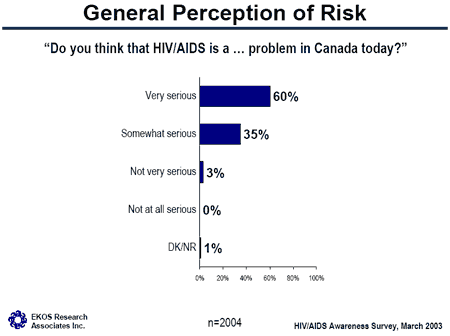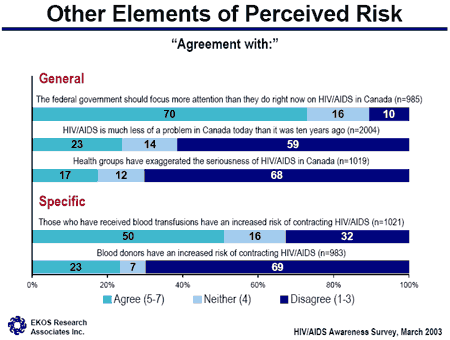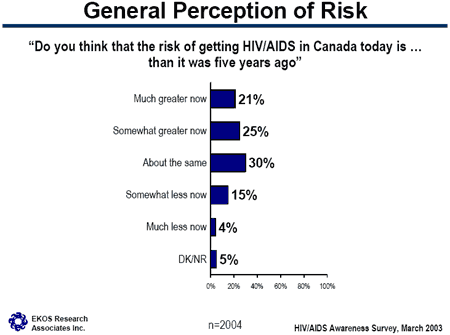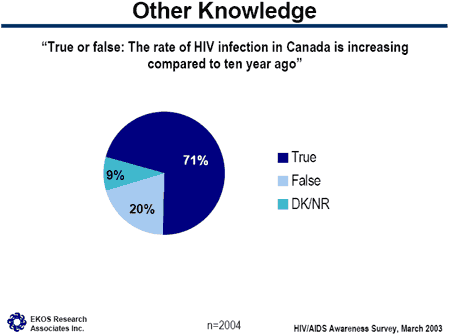Common menu bar links
Institutional links
Diseases & Conditions
Health & Safety
Research & Statistics
Agency Information
Search Box
HIV/AIDS - An Attitudinal Survey
Final Report
Previous | Table of Contents | Next
3. Perceptions of Risk
3.1 Severity
a) General Perception of Risk
Canadians were asked how serious a problem they think HIV/AIDS is in Canada today. Virtually all of Canadians (95 per cent) believe HIV/AIDS to be a somewhat serious (35 per cent) to very serious problem (60 per cent). The belief that HIV/AIDS is not a very serious problem was espoused by only three per cent of individuals and no one indicated that it is not at all serious.
The findings are generally consistent with past trends on the perception of risk. In April 2002, 59 per cent of Canadians believed that HIV/AIDS was a very serious problem1, while in August 2002, 54 per cent of Canadians held this view.2

- Higher proportions of residents in British Columbia and the Atlantic provinces (72 and 71 per cent, respectively) think that HIV/AIDS is a very serious problem, relative to the national average. Quebec residents, on the other hand, are more apt to minimize the problem (with 44 per cent perceiving it as a very serious problem and over half perceiving it as a somewhat serious problem).
- Women are more likely than men to believe that HIV/AIDS is a very serious problem in Canada today (64 per cent versus 57 per cent of men).
b) Perception of Personal Risk
When asked to rate their own personal risk of contracting HIV/AIDS, an overwhelming majority of Canadians (90 per cent) believe their risk to be low. Seven per cent believe their risk of contracting HIV/AIDS is moderate and a high risk is perceived by only one per cent.

- The perceived low risk of contracting HIV/AIDS is consistent across most demographic sub-groups. Youth (under 25) and the lowest income Canadians (less than $20,000) typically perceive slightly higher risk for themselves when compared to Canadians overall (13 and 12 per cent said a moderate risk, respectively).
- Canadians with lower levels of knowledge about HIV/AIDS also perceive a slightly higher risk of contracting the disease (12 per cent perceive a moderate or high risk).
- Visible minority and Aboriginal Canadians are less likely than Canadians overall to perceive themselves to be at low risk (82 and 84 per cent, respectively).
- Although the perception of risk is very low across the Canadian population in general, it is somewhat higher among individuals who reported a casual sexual partner (25 per cent of these individuals reported themselves to be at moderate or high risk, although the average rating was still 2.1 on a seven point scale, where seven is the highest risk). Individuals reporting multiple partners also perceive themselves to be at a somewhat high risk of contracting HIV (16 per cent of those with two partners and 30 per cent of those with three partners in the past six months provide a rating of three or more on the seven point scale).
| So, higher levels of risk of HIV/AIDS infection are perceived among youth, the lowest income Canadians and those with lower levels of knowledge about the disease. This is also true of visibly minorities, Aboriginal Canadians, and those who reported a casual or multiple partners. |
c) Other Elements of Perceived Risk
Canadians were asked to indicate whether they agreed with several different statements related to the risk of contracting HIV/AIDS. In terms of overall perception of risk today, just over two in three Canadians believe that the federal government should focus more attention on HIV/AIDS (70 per cent) and that Health Care groups have not exaggerated the seriousness of HIV/AIDS (68 per cent). Fifty-nine per cent do not believe that HIV/AIDS is much less of a problem today than it was 10 years ago.
With respect to specific risk factors, about half of Canadians believe that those who have received blood transfusions have an increased risk of contracting HIV/AIDS (50 per cent), but two in three Canadians do not believe that blood donors have an increased risk of contracting HIV/AIDS (69 per cent).

- A higher proportion of residents in Quebec believe that the federal government should pay more attention to HIV/AIDS (77 per cent), whereas proportionately fewer residents in British Columbia agree with this statement (59 per cent), than the national average.
- Canadians with the lowest income are also more likely to believe that the federal government should pay more attention to HIV/AIDS (82 per cent), as are Canadians who believe that HIV/AIDS is a serious problem and those who actually know someone with the disease (75 per cent in each group).
- Individuals with low self-rated knowledge are less likely than average to believe that more federal involvement is needed (60 per cent).
- Seniors, lower education and income individuals, and those who were born outside Canada are more likely than other Canadians to believe that health groups have exaggerated the seriousness of HIV/AIDS (24 to 29 per cent), as are Canadians with low (actual) knowledge of HIV/AIDS (30 per cent).
- Individuals who believe HIV/AIDS is a serious problem and those who know a person with HIV/AIDS are less likely than others to feel that claims have been exaggerated, as are residents in the Atlantic provinces (a range of 72 to 80 per cent disagree).
- Western Canadians (British Columbia, Alberta and the Prairies) are more apt to feel that HIV/AIDS is at least as much of a problem today as it was ten years ago. This view is also associated with higher levels of education and income.
- Individuals who believe that HIV/AIDS is a serious problem and that the risk of contracting HIV/AIDS is greater today are also more inclined than others to believe that it is at least as much of a problem today as it was 10 years ago (64 and 71 per cent, respectively), as are people born in Canada (61 versus 49 per cent of those born outside of Canada).
- Seniors are more likely than younger people to believe that HIV/AIDS is less of a problem today (35 per cent), as are Canadians with low (actual) knowledge of HIV/AIDS (30 per cent).
- Perceived risk of getting HIV/AIDS through blood transfusions increases with perceived risk generally of contracting the disease today, compared to five years ago. For example, 54 per cent of those who perceive a high general risk also agree that there is a higher risk from blood transfusions. Canadians who tend to minimize the seriousness of HIV/AIDS today are less apt to believe that there is an increased risk from blood transfusions (37 per cent disagree with the statement).
- A higher proportion of residents in the Atlantic Provinces believe that giving blood increases the donor's risk of contracting HIV/AIDS (35 per cent). This is also the case with senior citizens (29 per cent), lower education and income individuals, Canadians born outside of Canada (31 per cent) and those with low (perceived and actual) knowledge (33 and 38 per cent, respectively), as well as Canadians who believe that the risk of contracting HIV/AIDS has increased (28 per cent).
- Canadians between the age of 35 and 44 are least likely to perceive an elevated risk for blood donors.
| In general, residents of Quebec, those with the lowest income, individuals who know someone with the disease and those who believe HIV/AIDS is a serious problem are more apt to believe that the federal government should pay more attention to the disease. On the other hand, seniors, those with low (actual) knowledge, lower education and income individuals and those born outside Canada are more likely to think that the seriousness of the disease has been exaggerated. Residents of Western Canada, those with high education and income, and those born in Canada are more apt to see the disease as much of a problem now as it was ten years ago. Blood transfusions are seen as more of a risk among those who generally perceive a higher risk of contracting the disease now compared to five years ago. Those in the Atlantic Provinces, seniors, low education and income individuals, those born outside Canada and those with low (actual and perceived) knowledge perceive a higher risk of contracting HIV/AIDS by giving blood. |
Survey respondents were also asked to indicate their agreement with several statements regarding HIV/AIDS as a disease belonging to other people. The majority of Canadians do not believe that HIV/AIDS is a disease that mostly infects third world inhabitants (61 per cent), gay people (69 per cent), and/or drug users (73 per cent).

- Relative to other Canadians, Quebeckers are much more likely to believe that HIV/AIDS is mostly a gay person's disease (32 per cent). Residents of the Atlantic provinces, and Ontario, on the other hand tend not to believe this. Atlantic residents are most resistant to the idea of HIV/AIDS as a drug user's disease.

- A higher proportion of senior citizens perceive the disease as being mostly a gay person's disease (35 per cent), a third world disease (41 per cent) and a drug user's disease (29 per cent), relative to the views of younger Canadians.
- Canadians with lower levels of education and income are more apt to view HIV/AIDS as belonging to other groups as well (31 to 32 per cent of the lowest education and income individuals agree that it is a third world disease and 20 to 21 per cent see it as a drug user's disease). This is also the case with Canadians born outside of Canada, relative to those born in Canada (with 32 per cent thinking it's a third world disease and 24 per cent saying it's a drug user's disease).
- Canadians with low (perceived and actual) knowledge levels of HIV/AIDS are more apt than those with more knowledge to view it as a disease experienced by others (32 to 35 per cent of low knowledge individuals say that it's a third world disease, and 24 to 25 per cent say that it's a gay person's disease).
- Men are more likely than women to perceive HIV/AIDS as a third world disease (32 versus 24 per cent of women). This is also the case with Canadians who believe that HIV/AIDS is a moderate (rather than a serious) problem in Canada (32 per cent).
- Canadians who are 24 to 44 years of age are more resistant than their younger and older counterparts to the idea that HIV/AIDS is a gay person's disease and those who are 35 to 64 are least likely to see it as a drug user's disease.
| In summary, residents of Quebec, seniors and those with low (actual and perceived) knowledge of the disease are more likely to consider HIV/AIDS as belonging primarily to other groups. This is also the case among men, those with lower education and income, those who were born outside Canada and those who believe the disease is a moderate (rather than a serious) problem. |
A factor analysis was conducted to determine the risk-related items, which were answered in a similar way, with some interesting results. While it was expected that a "risk" scale or index would be the likely result, in fact there were few items that coalesced in this way. There was, however, a series of items, which were, responded to in a similar fashion, including agreement with statements about HIV/AIDS being a gay person's disease, a drug user's disease, and a third world disease. The index also includes respondents' level of agreement with the statement that people who contract HIV/AIDS through sex or sharing drug needles get what they deserve. This series of responses, taken together in a single index, is interpreted as a "distancing factor". That is, the higher the score the more a respondent tends to distance him or herself from the issue of HIV/AIDS. One in four scored low on this index. That is, they tend not to think of HIV/AIDS as an issue belonging to someone else. One in three scored in the medium range and almost half scored high on this index (and tend to think of this as a very compartmentalized issue, that likely would not affect them directly).

- People who tend to distance themselves from the issue of HIV/AIDS are also more apt to have low knowledge levels (actual and perceived). (For example, they are more likely to cite alternatives to blood tests as a method of detection. They are also more apt to believe that HIV/AIDS can be cured if treated early.)
- People who distance themselves from HIV/AIDS also tend to minimize the seriousness of the problem and to believe that health groups have exaggerated the seriousness of HIV/AIDS.
3.2 Trends Over Time
a) General Perception of Risk
Canadians were asked to indicate whether they thought the risk of contracting HIV/AIDS has changed within the last few years (e.g., more or less of a risk). Overall, 46 per cent of respondents believe that the risk of contracting HIV/AIDS is higher today than it was five years ago (combining much greater and somewhat greater together). Thirty per cent think the risk is about the same, and 19 per cent perceive less of a risk today. There has been an increase in the perceived level of risk of contracting HIV/AIDS. In 2002, 36 per cent of Canadians indicated a higher level of risk compared to five years ago.3

- More residents in the Prairies perceive the risk as being greater today (55 per cent). Those born in Canada are more likely than those born outside of Canada to believe that the risk is greater today (47 versus 40 per cent).

- Youth (under 25) believe that the risk of contracting HIV/AIDS is higher today (59 per cent). On the other hand, individuals who are 35 to 44 are least likely of all age groups to think that the risk is higher today (38 per cent).
- Those in the highest income group ($80,000 and more) and university graduates are less likely to believe the risk is greater today (39 and 40 per cent, respectively).
- Canadians who believe the disease is a serious problem are also more apt to believe that the risk of contracting HIV/AIDS is greater today, as are those with high (perceived or actual) knowledge (51 per cent for each group).
b) Other Knowledge
Canadians' perceptions of today's rate of HIV/AIDS infection in Canada were also obtained. The majority (71 per cent) believes that the rate of HIV/AIDS infection is increasing compared to ten years ago. One in five do not believe this (20 per cent) and nine per cent were unable to answer this question.

- Both Ontario residents and men are less apt to perceive the rate of infection as increasing compared to ten years ago (65 per cent).
- Youth are more likely than older groups to perceive an increase in the rate of infection (80 versus 65 to 72 per cent), as are those born in Canada (73 per cent).
- Not surprisingly, Canadians who believe that risk of infection had increased in the last five years also believe that the rate of infection has gone up (91 per cent).
- Higher levels of education and income are associated with lower proportions believing the rate of infection in Canada is increasing.
- Canadians who do not feel that HIV/AIDS is a serious problem in Canada are also less likely to believe that the rate of infection is increasing (65 versus 75 per cent for those who do see it as a problem).
c) Perceived Increase of Risk
Canadians were asked to indicate whether they thought behaviours such as HIV testing, safer sex practices and other means of protecting others from getting infected had decreased, increased, or stayed the same over the last 10 years. Most Canadians tend to believe that all three types of behaviours have increased over the last ten years.
The majority of Canadians (72 per cent) believe that more HIV tests are performed today. Only 15 per cent think that the rate of HIV testing is the same. Just under two in three Canadians believe that HIV/AIDS infected people take the steps necessary to protect others from getting infected (61 per cent) and 22 per cent believe that the frequency has not changed over the last 10 years. Just over half of Canadians feel that safer sex practices have increased over the last 10 years (58 per cent), while 26 per cent believe the frequency of these practices has stayed the same and 11 per cent feel they have decreased.

- Residents in Alberta are somewhat more likely to think that there has been an increase in HIV testing (78 per cent).

- The proportion of Canadians believing HIV testing has increased tends to go down with increasing age (from 83 per cent for the youngest age category to 59 per cent for the oldest). Canadians with low (perceived or actual) knowledge are less likely to perceive an increase in HIV testing (59 and 68 per cent, respectively).
- Quebec residents are more likely than those from other regions to perceive a status quo in the degree to which HIV/AIDS infected people take the steps necessary to ensure that others are not infected (28 per cent).
- The proportion of Canadians believing HIV/AIDS infected people take steps to protect others also tends to go down with increasing age (from 70 per cent for the youngest age category to 48 per cent for the oldest).
- Lower education and income Canadians and people born outside of Canada are less apt than others to perceive a rise in protective behaviours (53 per cent), as is the case with Canadians with low (perceived or actual) knowledge about HIV/AIDS (55 and 57 per cent, respectively).
- A higher proportion of residents in Ontario believe that safer sex practices have increased (67 per cent). Quebec residents, on the other hand, are much less inclined to believe this (45 per cent).
- Canadians aged 44 and younger are more likely than older Canadians to believe that there has been an increase in safer sex practices (61 to 67 per cent), as is also the case with Canadians born outside of Canada, and Canadians who feel that there is less risk of HIV/AIDS infection (68 per cent).
- Canadians who know a person with HIV/AIDS are somewhat less likely than others to feel there has been an increase in safer sex practices (54 versus 60 per cent).
- Canadians with high self-rated knowledge are more likely to believe that the rate of occurrence has stayed the same (33 versus 24 per cent).
| In summary, Canadians with the lowest income are more likely to perceive a decrease in safer sex practices. In general, seniors and those with low self-rated knowledge of HIV/AIDS are less likely to perceive an increase in HIV testing. These same groups, in addition to low education and income and foreign-born individuals are less apt to perceive an increase in the degree to which steps are taken by infected people to protect others from contracting HIV. Residents of Quebec and those over the age of 45 are less apt to perceive an increase in safer sex practices over the past ten years, as are those who know a person with the disease. |
- Injection Drug Use Survey, Ipsos Reid, April 2002.
- Decima Express, Decima Research Inc., August 2002.
- Decima Express, Decima Research Inc., August 2002.
